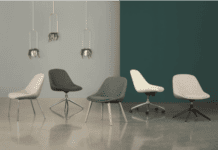Today, the United States Tennis Association (USTA) officially opened the new Louis Armstrong Stadium at its site in Flushing, NY with a dedication ceremony on “Queens Day” at the US Open Tennis Championship. For 40 years, Louis Armstrong Stadium played host to some of the most memorable moments in tennis history. Today, the USTA opened a new 14,000 seat stadium, complete with retractable roof.
Four-time US Open champion John McEnroe joined internationally acclaimed musician Wynton Marsalis and former New York City Mayor David Dinkins in officially opening the new Louis Armstrong Stadium at a dedication ceremony on August 22, 2018, hosted by USTA President Katrina Adams.

At the ceremony Adams stated that the new stadium facility “will provide the US Open’s great players with another grand stage on which to perform, and also provide our world-class fans another great venue to experience all the thrills and excitement of those performances.”
The stadium, the final piece of a $600 million five-year strategic transformation, will be used for its first official match when the main draw of the 2018 US Open begins on August 27, 2018. The stadium will also host a dedicated night session for the first week of the tournament, giving the US Open two stadia with night matches for the first time in tournament history.
Other dignataries joining Adams on stage were Queens borough president Melinda Katz; Oscar Cohen, a founding member of the Louis Armstrong Educational Foundation; USTA Billie Jean King National Tennis Center Chief Operating Officer Danny Zausner; and Rossetti Architects president Matthew Rossetti. Members of PS143Q Elementary School and the Louis Armstrong Educational Foundation and Museum were also in attendance, as were ambassadors for Net Generation, the official youth tennis of the USTA.
Added McEnroe, who followed up the formal dedication by playing played an exhibition match with brother Pat against James Blake and Michael Chang, “Alright, this is awesome. I know the players are going to be super excited. As a New Yorker and as a Queens boy, I couldn’t be prouder of this stadium.”
New Furnishings For New US Open Courtscape
Earlier this week, on August 20, the USTA and renowned design firm Michael Graves Architecture & Design (MGA&D) unveiled a new collection of courtscape furniture for the US Open. In December 2017, the USTA selected Michael Graves Architecture & Design in to re-imagine the courtside furniture for this year’s celebration of the US Open’s 50th anniversary and to help launch America’s Grand Slam toward the next 50 years. The new furniture is designed to enhance the US Open experience for players, officials and fans alike. It was manufactured by Landscape Forms, an industry leader in beautifully designed furniture for outdoor spaces. The furniture seen here is installed at the facility’s Arthur Ashe Stadium.

The new furniture is part of the US Open’s rebranding effort. The goal was to create a modern, well-organized courtscape that would be iconic to the US Open and its New York location, while keeping the main focus on the action on the court. The collection includes new seating for the players, umpires and line judges, a “cooler corral” for the players, plus other accessories.
MGA&D specializes in humanistic design that is not only beautiful, but serves its purpose in an artful way. To help inform the ultimate design of the furniture, MGA&D’s design team met with various US Open stakeholders, including players, officials, fans, sponsors, and broadcast partners, as well as the USTA’s facilities and maintenance, sponsorship and marketing, broadcast and technology crews. MGA&D then distilled the research into a design brief to create the furniture based on three guiding principles: visibility, usability, and functionality.

The furniture evokes elements of the New York City landscape. For example, the new players’ seating was inspired by the city’s park benches and serves as a metaphor for a body at rest, which is what research showed is important for the players. The player seating is sponsored by Ralph Lauren Polo.
The umpire stand features a cantilevered design, reminiscent of cantilevered details on buildings in the city, while providing open site lines for fans to see the court. It also utilizes the idea of forced perspective to further reference the soaring skyscrapers of New York City. The stand is designed to be comfortable, incorporate the latest technology and provide sufficient support for the umpire to quickly ascend or descend. In addition, all pieces in the collection are easy to clean, and allow for quick-and-easy installation and removal by facilities crews.

To deliver the new furniture for this year’s 50th anniversary tournament, the project schedule was aggressive. MGA&D utilized virtual reality to enable the USTA to envision each design concept. The technology allowed the wide team of stakeholders to make well-informed decisions from each of their perspectives.
“The new furniture is beautiful and truly captures the high performance of the US Open,” said Stacey Allaster, USTA chief executive, professional tennis. “The tournament is of New York, and the new courtscape is a perfect expression of the Grandest Slam.”

“I am passionate about furniture design, and this has been one of the most satisfying projects I’ve worked on during my 35-year product design career,” said Donald Strum, MGA&D’s principal, product design. “Seating should express utility, be comfortable and carry a beautiful personality as well. The various performance requirements of this collection made the project endlessly fascinating.”
“Working with the expert team from Michael Graves Architecture & Design on this complex and fast-track project was critical,” says Landscape Forms Executive Vice President of Development Robb Smalldon. “They know product design inside and out, and we know engineering and manufacturing. Our teams coordinated well and developed a fluid back-and-forth that culminated in a beautiful, functional product for a high-visibility venue. We are honored to work with leading design thinkers like Michael Graves Architecture & Design and a great end-client like the USTA.”






















![[VIDEO] Collect Asset Data at the Speed of Walking a Building](https://facilityexecutive.com/wp-content/uploads/2024/02/maxresdefault-324x160.jpg)